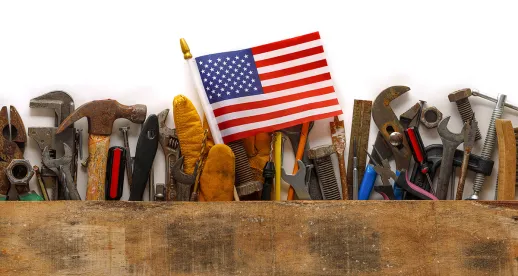Change is in the air for the Buy American Act (“BAA”). On July 30, 2021, the Federal Acquisition Regulatory Council published a proposed rule to the Federal Acquisition Regulation (“FAR”) to implement President Biden’s Executive Order 14005, on “Ensuring the Future is Made in America by All of America’s Workers,” which seeks to further strengthen U.S. Buy American laws and further encourage domestic procurement (previously discussed here). A public meeting to discuss the proposed rule is scheduled for August 26, 2021, and comments will be due September 28, 2021. This blog article summarizes the new BAA proposed rule, offering a primer in advance of the public meeting next week and the public comment deadline next month. Yes, folks – change is in the air. Fasten your seatbelts; we may encounter some turbulence ahead.
I. Summary of the New BAA Proposed Rule
The proposed rule seeks to accomplish three main objectives:
-
Increasing the Domestic Content Threshold. The proposed rule would increase the domestic content threshold for domestic end products (currently set at 55% pursuant to a final rule published in January 2021), to 60%, also proposing gradual increases over the next several years until the threshold reaches 75%. The proposed rule also would create a “safety valve” of sorts to allow the government to accept products at slightly lower levels, reducing the risk of the heightened domestic content requirements disrupting the government’s ability to buy what it needs;
-
Creating a New Class of “Critical” Items and Components Requiring Extra Attention. The proposed rule would create a new class of “critical items” and “critical components” – products “deemed critical to the U.S. supply chain.” These “critical” items would receive extra scrutiny, as well as an enhanced price preference (when comparing the price of the domestic product to a potentially cheaper foreign alternative).
-
Establishing a New Postaward Reporting Requirement. The proposed rule would impose new reporting requirements, asking contractors to identify the amount of domestic content in each “critical” item, including domestic end products incorporating “critical” components. The reports will be submitted to the new “Made in America Office” at the White House’s Office of Management and Budget.
Notably, the FAR Council has not (yet) proposed replacing the BAA “component test,” despite Executive Order 14005 calling on regulators to do so with a more expansive “domestic content” test looking to the total added value of U.S. processes, labor and know-how (not just the cost of the components, which is the case under current rules). Instead, the FAR Council is soliciting public comments on how the current “component test” operates in practice and how it might be improved moving forward.
-
Increasing the Domestic Content Threshold
Currently, to qualify as a “domestic end product” under the BAA, a product must both: (a) be manufactured in the U.S.; and (b) satisfy the domestic content requirement. There are two separate measures of the “domestic content” requirement: (1) for products made wholly or predominantly of iron or steel, the domestic content must be greater than 95% of the total cost; and (2) for other manufactured products, the cost of components mined, produced, or manufactured in the U.S. must exceed 55% (recently raised from 50%) of the total product costs.
The proposed rule does not suggest changing the domestic content requirement for products made wholly or predominantly from iron or steel. But the proposed rule would raise this domestic content threshold further for other manufactured products – from 55% to 60% immediately, then to 65% in two years (calendar years 2024 through 2028), and eventually to 75% five years thereafter (beginning calendar year 2029). As such, the FAR Council proposes to amend the FAR’s definitions of “domestic construction material” and “domestic end product” in FAR 25.003, as well as the related FAR clauses (FAR 52.225-1, 52.225-3, 52.225-9, and 52.225-11). Notably, these increases automatically will apply to multi-year contracts that span multiple threshold requirements – meaning, contractors would be responsible for ensuring they meet the then-current threshold requirement, regardless of what requirement might be incorporated into a contract.
The proposed phased approach to increasing the domestic content threshold for other manufactured products is designed to give contractors the opportunity to adjust their supply chains incrementally. But it also includes a “fallback” threshold, designed to give the Government a little more flexibility in identifying and accepting products as the domestic content threshold continues to climb. For up to a year following the domestic content threshold increase to 75%, the proposed rule would allow the Government to purchase products that meet the current 55% domestic content requirement “in instances where end products or construction materials that meet the new domestic content threshold are not available or are of unacceptable cost.” In other words, products and construction materials (other than those made wholly or predominantly of iron or steel), that do not meet the heightened domestic content requirements, will be deemed “domestic end products” if they meet or exceed the former domestic content threshold. This fallback only applies, though, if: (1) there are no domestic end products that meet the current threshold requirement; or (2) those that are available are of unreasonable cost after imposition of a price preference.
One additional point is worth noting. Currently, the “domestic content” requirement does not apply to manufactured products (other than products made wholly or predominantly from iron or steel) that qualify as “COTS” or commercially available off-the-shelf products (as defined in FAR 2.101). That means when the government buys COTS manufactured products (other than products made wholly or predominantly from iron or steel), a vendor need only consider where the end product was manufactured – no need to worry about where the components came from. While this partial exception relieves COTS vendors of a significant administrative burden, the Biden Administration is currently reviewing whether the exception should remain. More on this below.
-
Enhanced Price Preferences for Critical Items and Components
Importantly, the BAA does not outright prohibit the Government from buying foreign-made products. Rather, there are many exceptions to the BAA, including (most commonly) when a domestic end product is more expensive than the foreign alternative. Accordingly, the FAR imposes price evaluation preferences to those contractors providing domestic end products, adding an evaluation penalty to offerors containing foreign end products prior to evaluating the proposed price. Currently, the evaluation preference ranges between 20-30% (50% for purchases by the Department of Defense). The Proposed Rule seeks to impose additional price preferences for “end products and construction material deemed to be critical or made up of critical components.” This idea of “critical” materials is new, and would create a two-tiered evaluation process – one process for “normal” materials and a heightened process for “critical” materials. “Critical components” would be defined as those components that are “mined, produced, or manufactured in the United States and deemed critical to the U.S. supply chain,” and “Critical items” would be defined as “domestic construction material or domestic end product that is deemed critical to the U.S. supply chain.”
To implement these changes, the Proposed Rule would add these definitions to FAR part 25 (and the applicable FAR clauses), and would include (eventually) a list of “critical items and components” to a newly designated FAR 25.105, which will be identified in a separate, later rulemaking (presumably the types of critical products in the supply chain that the White House is currently working on identifying, discussed here and here). Contractors also would be required (per updates to FAR 52.212-3, 52.225-2, and 52.225-4) to identify, in their proposals, domestic end products that contain “critical” components in order to highlight the items and facilitate the Contracting Officer’s ability to impose higher price preferences during the proposal evaluation process (implementing the processes outlined in FAR Subpart 25.5).
-
New Postaward Reporting Requirements
Under the Proposed Rule, contractors would be required to report “the specific domestic content of critical items, domestic end products containing a critical component, and domestic construction material containing a critical component, that were awarded under a contract.” To implement these regulations, the Proposed Rule seeks to add two additional reporting clauses for supplies and construction materials: FAR 52.225-XX, Domestic Content Reporting Requirement—Supplies, in solicitations and contracts containing 52.225-1 or 52.225-3; FAR 52.225-YY, Domestic Content Reporting Requirement—Construction Materials, in solicitations and contracts containing 52.225-9 or 52.225-11.
Proving that the Government can invent numbers that support their needs (and without any substantive description), the proposed rule estimates that the new reporting requirement “is estimated to average 0.63 hour per response,” or 37.8 minutes per response. This estimate seems to miss the point – while it may well take no more than 40 minutes to complete the new proposed form, the time it will take for a contractor to gather information to validate the implicit certification inherent in the form will take countless hours. Thankfully, the proposed reporting requirement would not apply to COTS products.
The FAR Council welcomes feedback on the burden associated with this new reporting requirement.
II. August 26, 2021 Public Meeting and Call for Comments
The Proposed Rule calls for public comment on a number of topics, some reaching far beyond the scope of Executive Order 14005’s mandate, but all of which relate to the Biden Administration’s stated goal of advancing “Buy American” priorities. The Proposed Rule specifically seeks comment on the following topics, due September 28, 2021, which certainly will be discussed at the August 26 meeting:
-
Removal of COTS Waiver – Since 2009, the FAR Councils have waived the domestic content requirement under the BAA for some COTS products. Though this waiver no longer applies to products made wholly or predominantly from iron or steel (as of January 2021), the FAR Council is seeking public comment regarding whether: (1) the COTS waiver benefits domestic companies; (2) the waiver should be narrowed or lifted; (3) the application of the COTS waiver has met its intended purposes; and (4) the Government should separately collect information on COTS products.
-
Trade Agreements Act – The Proposed Rule seeks information on the effect of the regulatory suspension on the BAA’s component test on purchases subject to the Trade Agreements Act (currently, those contracts valued at $182,000 or more).
-
Removal of Commercial Item IT Exception – Since 2005, “commercial items” of “information technology” (as those terms are defined at FAR 2.101) have been exempted from the BAA requirements under the FAR. However, Executive Order 14005 requested the FAR Council consider removing this exemption moving forward. The FAR Council is seeking public comment on this suggestion, including whether and the extent to which the original purpose of the exception is still relevant, in what circumstances the waiver could be narrowed or lifted, and the potential impacts of removing the waiver.
-
Services – The FAR Council seeks public comment on how the Government can further promote the use of Made in America services – a topic largely overlooked in prior BAA rulemakings because the BAA only applies to products and supplies, not services. See 41 U.S.C. § 8302.
-
Product Specific Regulations – As mentioned above, the Trump Administration carved out a higher domestic content requirement for products made wholly or predominantly from iron or steel. The Proposed Rule now seeks comment on whether other products or categories of products should be subject to higher domestic content thresholds (including, potentially, the “critical” items and components that will be newly added at FAR 25.105).
* * * *
Don’t like what you’re reading here? Overjoyed that the U.S. Government is finally taking “Buy American” more seriously? The FAR Council is accepting public comments through September 28, 2021 and via the public meeting on August 26. Contractors are strongly encouraged to use this opportunity to better educate the FAR Council on the impact such measures – including potential future measures – would have on contractors, their supply chains, and the price of compliant domestic end products. Given the Biden Administration’s continuing focus on “Buy American,” a final rule could come as quickly as December 2021.
Change is in the air. Change will happen. Please be prepared. As Bette Davis warned in All About Eve, “Fasten your seatbelts; it’s going to be a bumpy night.”




 />i
/>i
